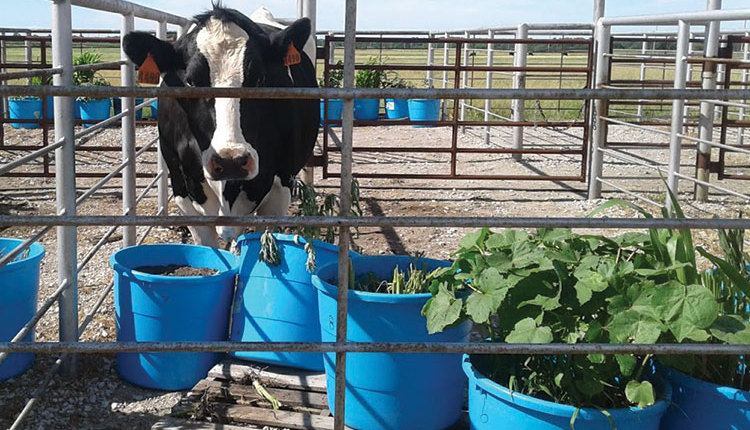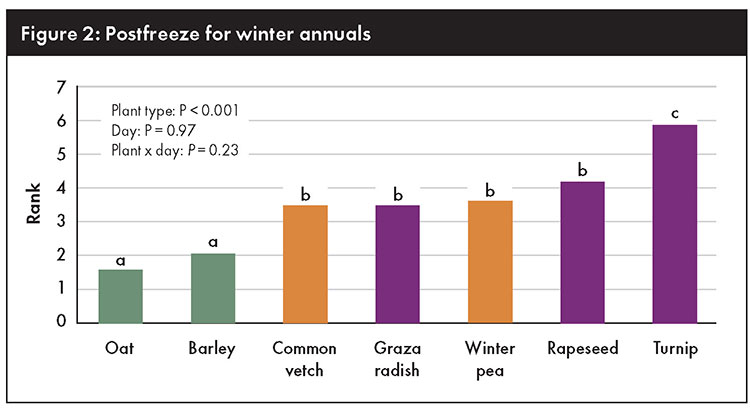The author is an associate professor and a beef systems extension specialist with Kansas State University.

Cover crops are a conservation management tool in grain production that are used to enhance soil properties, reduce erosion, control weeds, and play a role in water management. However, there are costs associated with establishment and termination of cover crops, and oftentimes the economic returns are slowly recaptured, if measurable at all.
One way to quickly recoup the cost of cover crops is to use them as an annual forage for livestock. Integrating cattle (or other livestock species) into cropping systems offers many benefits to production agriculture, such as diversification, spreading risk, improving the ecological production of crops, and offering positive economic returns.
When a producer is determining which cover crops to plant, there is a very large list of acceptable plant species (over 50 in many regions of the U.S.). The good thing about this exhaustive list of species is that plant selection can be tailored to a specific operation’s objectives. However, when trying to make decisions from a cattle performance perspective, that large list becomes daunting.
From a nutritional standpoint, many annual forage options can be valuable for livestock, assuming they are harvested prior to plants reaching reproductive stages. There have been many publications and research projects that have looked at the biomass production and forage nutritive values of annual forages, but few have evaluated how that also corresponds to palatability and acceptability by livestock.
What do cattle prefer?
At Kansas State University, we were interested in evaluating cattle preference for a variety of popular cover crops that producers were also grazing. We felt that knowing preferences for these forage types could be useful in a strategic plant species selection process. Depending on an operation’s goal, a producer may want to plant only the species that are highly preferred by livestock to maximize potential intake and gains. Conversely, they may want to strategically pick some plant species that cattle will not consume as readily to guarantee an appreciable amount of biomass is left in the field for soil health improvement and maintenance. This might aid in the building of organic matter and improving the soil’s carbon-to-nitrogen balance.
Three studies were completed that evaluated cattle preference for annual forage/cover crop plant species. The first project looked at fall (prefreeze) grazing of annual forage plant species. Eight different species were planted in repurposed protein tubs on the same date in August. Three Holstein heifers that had never been exposed to any of the plant species were placed in pens with the annual forages, and the rank of consumption for the plants was determined.
In the first study, the preferred order of selection was winter barley, a tie for second with Austrian winter pea and Graza forage radish, and then there was no difference in selectivity between a whole host of other brassica plants (purple top turnip, Impact collard, yellow mustard, Trophy rapeseed, and Bayou kale; see Figure 1).

In the prefreeze set of plants, it was interesting to see that Graza forage radish was much more highly selected among the brassicas. Upon further investigation, it had a much lower concentration of glucosinolates, which offer a very bitter flavor for cattle. We believe that is why cattle preferred the forage radish over other brassicas. Additionally, it was surprising to see the behavior of the cattle in regard to essentially preferring the winter pea and forage radish to the same degree.
When watching the cattle on recorded video, they would initially sniff and walk away from the winter pea, then go take some bites of other forages. However, once they took a bite of the winter pea, they consumed all the plants that were in the tub. It seemed as if there was something in either the structure of the plant or a smell that was undesirable to the cattle until they actually consumed the winter pea, and then they really liked it.
Postfreeze selection differed
During the following winter, a similar study was conducted with four Holstein heifers offered a few more legume and grass options. This time, we waited to collect preference information until after a killing freeze. Once again, the cereal grass species of winter oat and barley were the most highly preferred, with no difference between the two (see Figure 2). The intermediate preference plants were common vetch, Graza forage radish, Austrian winter pea, and Trophy rapeseed. Purple-top turnips postfreeze were the least preferred forage of the group.

It was interesting to see that the rapeseed plant did improve eating quality after a freeze to be the same preference as the Graza forage radish, which was much more highly preferred before a freeze. There is a significant price difference in these two brassicas, and timing of consumption needs to be accounted for in their selection criteria.
Liked the sorghums
There are many warm-season annual forages that are planted in Kansas for feed, so we looked at cattle preference of these annual forages for grazing. As with the fall/winter annuals evaluated, the warm-season grasses were more highly preferred as compared to other plant species. But even within the grass species, forage sorghum and sorghum-sudangrass were more highly preferred as compared to pearl millet (see Figure 3). This was an interesting observation, and we thought it might have been due to high nitrates in pearl millet, as pearl millet often has a higher nitrate concentration than other warm-season grasses.

We tested the forages and found that the lowest nitrate value was actually in the pearl millet. Then we looked at plant structure, and the “grazed” pearl millet had a “hairy” leaf underside that was rough to the touch versus being smooth like the other grass species. This may have led to a less desirable eating experience for the heifers.
A third hypothesis as to the higher preference for the sorghums is that both hybrids used in the study had the brown midrib (BMR) trait. This may have led to improvements in palatability.
The intermediately preferred warm-season annual species consisted of sunflower and sunn hemp, and the least preferred were okra, mungbean, and safflower. We started grazing these plant species as soon as the sorghums were 2-feet tall to minimize prussic acid toxicity concerns. As such, the sunflower and sunn hemp were both very vegetative, especially as compared to the mungbean, which had already started growing pods. This is probably why it had a lower selection rank.
These studies were just “spot” tests of cattle preference; the animals had two days of feed available. We know that cattle can learn to consume less desirable feeds, so if selectivity was tracked through a whole season, we may see some differences in selectivity — or that there really is no difference. However, if working with growing calves, a few days to a week of spending time selecting away from a forage can inhibit weight gains enough that producers would be disappointed in their plant selection.
This article appeared in the March 2021 issue of Hay & Forage Grower on pages 18 and 19.
Not a subscriber? Click to get the print magazine.

